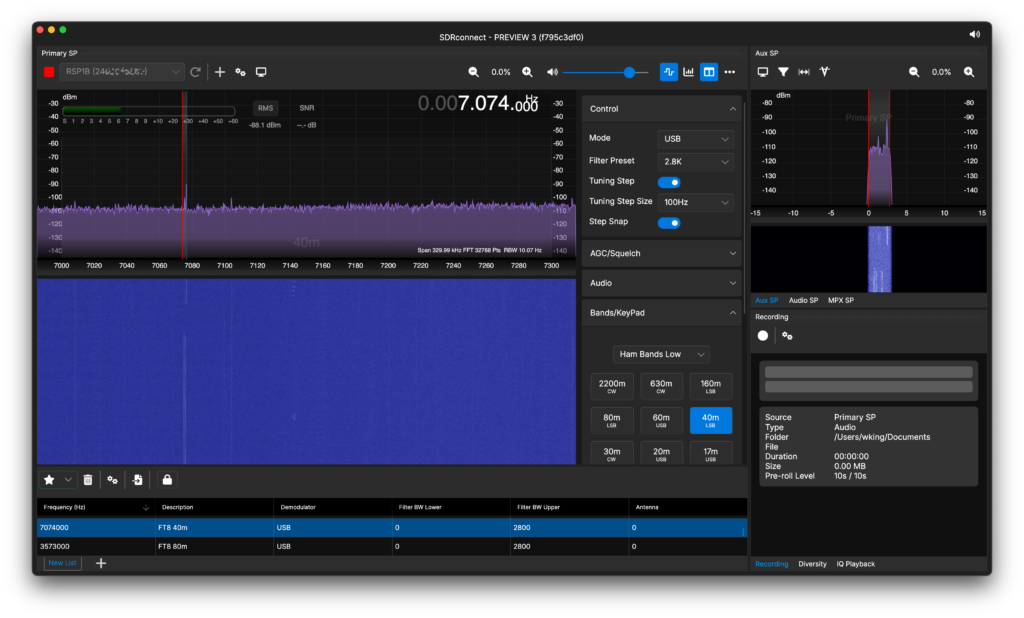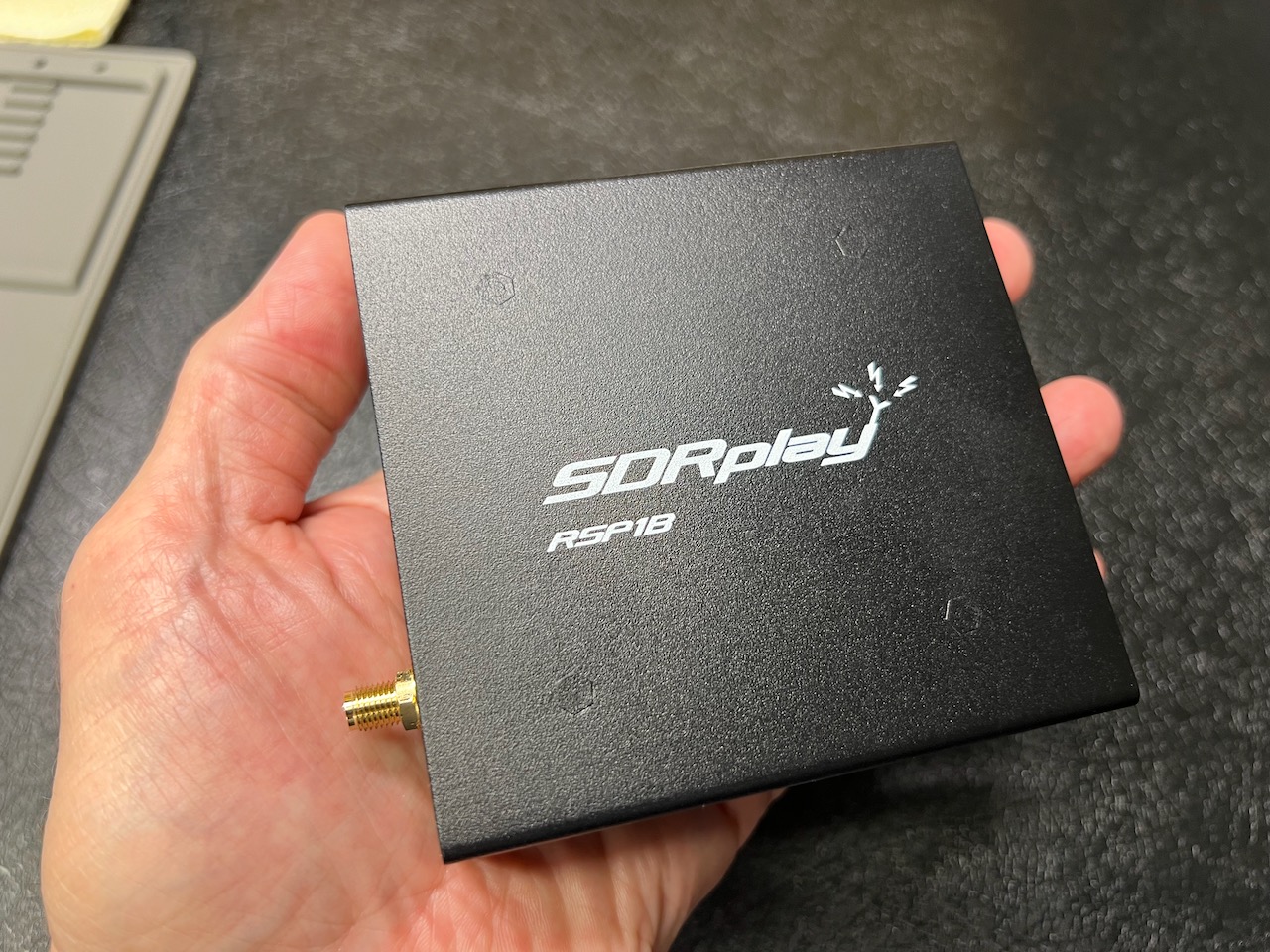After deciding to get back into ham radio (read more here), I needed to build a stealthy antenna for the HF (high frequency, a/k/a shortwave) bands in order to get back to the ham activities I truly enjoy (CW, or Morse code), and to take part in some of the newer types of fun that the hobby has to offer these days (like FT8, among other examples). But since a transceiver was still weeks away, I was chomping at the bit to see if the antenna I’d created at least allowed me to hear radio signals. (Transmitting, of course, is an entirely different question, but that would have to wait regardless.) That effort to kick the tires on my new antenna, however, didn’t work out so well.
The most straightforward way to see if the antenna was working in any meaningful way was to hook-up my old Realistic DX-440 radio, which was a rebranded Sangean ATS-803A portable radio that covers traditional broadcast bands as well as shortwave frequencies. It has an RCA connector on the back for external antenna connection, so it would be easy… Just connect that to the coax I’d just run into my future ham shack from my new antenna, and give it a go.
But wait; Realistic? Did I just say Realistic? Those of a “certain age” will remember the Realistic brand as one of the many house brands of the old Radio Shack chain, and yes, this portable receiver harks from those oldy, moldy days. I’d bought it new, and it’s been hauled around (and banged around) over the years. In truth, I’ve not had it out and powered-on in a very long time, but I had no reason to believe it wouldn’t do the job. So I connected it, and… nothing but static in the HF bands.
The DX-440 had apparently gone deaf (at least with shortwave), but not wanting to believe that it had, I took the it outside and used its internal telescoping antenna to check the bands, and still nothing. It could only mean one thing, really: The radio had decided to give-up the ghost in some important way, having been banged around one too many times, apparently. That, in turn, sent me into the direction of shopping for a new shortwave receiver, as I was determined to know right then whether the antenna did anything useful whatsoever.
Trouble is, in the internet era, shortwave listening isn’t the hobby it once was, and there just aren’t as many choices as there used to be. Worse, those with the necessary features (like receiving single sideband or SSB) were a real investment — an investment in something I actually didn’t intend to use that much, or for very long. But going down the rabbit hole allowed me to find a new type of receiver that I was unfamiliar with, given my long time away from the radio arts: the SDR, or software-defined radio.
My New Shortwave Receiver: An SDR
I had been blissfully unaware of just how much computer technology had invaded radio while I’ve been away from everything, and SDRs are a perfect example of it. To set the context here, I’ll quote the Wikipedia article on the topic:
Software-defined radio (SDR) is a radio communication system where components that conventionally have been implemented in analog hardware (e.g. mixers, filters, amplifiers, modulators/demodulators, detectors, etc.) are instead implemented by means of software on a computer or embedded system.
By shifting some of the conventional duties of a radio’s circuits into a separate computer and software stack, manufacturers are able to do some very interesting things, and do it at an impressive price point. The “radio” contains the bits needed to capture the RF, while much of the minutia of processing that RF can be shifted to software. And the stuff that can then come along for the ride? A laundry list of interesting and useful capabilities, like waterfall spectrum displays (which you can see in the screenshot accompanying this article, although the evening I took the images, the bands were not very active due to solar activity that particular day).
While SDR technology can be used for both transmitters and receivers, a great example of the latter was the radio I ended-up purchasing: the SDRplay RSP1B. Britain’s SDRplay makes a range of SDR receivers, and the RSP1B is one of several wideband general coverage units they offer. Capable of receiving VLF, LF, MW, HF, VHF, UHF and L-band transmissions — gapless coverage from 1kHz through 2GHz — it basically can receive just about anything you want to hear (with the right antenna, of course). And when it comes to transmission type, that, too, includes anything you might want or need… AM, wideband FM, narrowband FM, SSB, CW, and whatever else. And priced at around US$140, I figured it was affordable enough to justify.
The local Ham Radio Outlet (brick-and-mortar) store had them in-stock, so it was a no-brainer (after reading about them) to just head up and get one.
Perhaps the only downside to the SDRplay platform is that the availability of the required desktop software for non-Windows platforms is a relatively recent development, and their SDRconnect cross-platform software is still in an incomplete “preview” status. But while still in active development, everything I read suggested that it was adequately functional for my (Mac-based) needs.
The RSP1B in Practice
Using the RSP1B is straightforward enough; with the SDRconnect software installed, you merely plug the unit into an available USB port on your computer, connect a band-suitable antenna to the SMA coax connector, and run the software. Voila — a working radio, with all the relevant controls represented on-screen as UI elements, in lieu of switches and knobs on the radio itself.
The SDRplay website has all the relevant specifications and details about what it does and how it does it, so readers can go there if necessary. But after using the unit for several weeks now, I have some general thoughts.
The all-important software is still a bit buggy
The SDRconnect software, as I mentioned earlier, is still in active development, and is distributed in a “preview” edition as I write this article. You can expect bugs, and indeed, I’ve run into some:
- It does seem to want to crash periodically, although thankfully, not all that often.
- The reception seems to “glitch” momentarily on a somewhat regular basis (the audio dips briefly).
- On my Intel-based MacBook Pro (circa 2018), connecting to the radio is a bit troublesome; when I first load the software for a listening session, it doesn’t “see” the RSP1B connected. I click the refresh button, which causes the software to crash. Upon restarting it, it still won’t see the radio connected, but a click of the refresh button again will then work, and cause it to be recognized. I go through this dance every time I sit down to use it. Annoying, but not a show-stopper. (For the record, it works more reliably with my other Macs.)

The UI could use some work
The SDRconnect interface has a lot of stuff to render onto the screen, and a limited amount of space to put it in. But, I’m not convinced the SDRplay have necessarily made the right choices along the way when designing the UX/UI, and prioritizing things.
- Tuning the radio is far more difficult than it should be; just entering a frequency is somewhat painful and unintuitive. Something as useful as direct keypad frequency entry is buried, and doesn’t seem to work in a way that makes sense (to me, anyway). I tend to resort to clicking a preconfigured band selection button (bottom of the center column), then tuning around from there with a mouse scroll movement.
- Once you get it in the general area of what frequency you want to listen to, you can use mouse scroll movements to tune (as I just noted), but if you click off the main frequency spectrum window — to change the receiving mode, for example — the same scroll action will then modify whatever thing you just clicked, rather than tuning the frequency. To get back to tuning, you have to click in the spectrum window.
- Band preset buttons are at the very bottom of the center column of the default view, while the receiving mode and filter width is at the top of that column, resulting in an inordinate amount of scrolling up and down and back again as you use the radio — if the sections in between are expanded, anyway. (See the above screenshot for context.) I just don’t think that shoving all of that into a single, scrollable, columnar view is the optimal design.
- The interface for storing and retrieving frequency presets is more than a bit awkward as well. That it’s arranged in a table format at the bottom of the screen doesn’t help much.
- While it’s true that certain blocks of the UI can be moved around, or even unlocked to float, in practice, this behavior isn’t as useful as it seems. Not all blocks in the UI can be moved around, and the much as I’ve found with the Adobe software that I use daily, the process of docking and undocking is balky and unintuitive.
In short, I’m not sure that I’d call much of the UI is particularly logical, or, as I keep saying, intuitive. But this narrative makes it sound awful, and it’s not; it could just use some better usability overall, and some thought invested into the UX, and how a typical person will use the receiver — then ensuring that the most-used functions and controls are more directly at-hand without a bunch of scrolling, or opening/collapsing things. That, or increase the amount of modularity and configurability to allow the end user to choose what elements go where to meet their needs.
Great fun in a small package
While I might have my gripes, there’s no question that the SDRplay RSP1B is a powerful, affordable, compact receiver that fulfills its promise of receiving just about any type of radio transmission, assuming you have an appropriate antenna connected. (For laypeople who may be reading this, I should point-out that while the RSP1B can receive a signal doesn’t mean the signal is intelligible. For example, you cannot use this radio to “tap” cellular phone conversations, receive encrypted emergency services transmissions, and other types of encoded or encrypted transmission.)
Conclusions
I have no regrets about buying the SDRplay RSP1B, and I’ve used it quite a bit as I wait to get my transceiver in the near future. Will I use it in the future? Hard to know for certain, but I suspect it’ll be useful to keep around.
One option I’ll explore is using the RSP1B as a “panadapter” for the Icom IC-7000 that I’m slated to inherit soon. Early indications seem to suggest that it’s possible, but I have no idea if attempting it would be worth the effort — or is something that’s particularly in my technical wheelhouse.
More generally, however, perhaps the only downside is that it is an SDR; roll the clock forward ten years, and will the SDRconnect software still be available? Will it still work? Will it still be supported and updated? That, I suppose, is a roll of the dice with any computer-connected, computer-dependent, computer-centric solution to anything. But while there are old shortwave radios from 50 years ago that can still be fired-up and used today, I’m going to venture a guess that 50 years from now, nobody’s going to be firing-up an RSP1B; they won’t be able to.
Alas, I’m not planning to be around 50 years from now to find out, and as for worrying about the future, that’s a problem for another day. For now, I’d much prefer to pop back into SDRconnect, fire-up WSJT-X, and see who’s playing with FT8 this afternoon on 20 meters.

